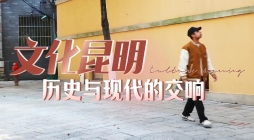Royal clues unearthed in excavation
Source: China Daily | 2022-01-12 | Editor:Lexi

Cultural relics on exhibition at the Taizicheng site include a jade decoration with a gyrfalcon pattern.
Items found at site near venue of Winter Olympics now on exhibition, Wang Ru reports in Zhangjiakou, Hebei province.
People in Taizicheng village, Chongli district, Zhangjiakou city, North China's Hebei province, say the village's name, which means city of the crown prince, is derived from the myth that royalty once lived there. In the 1970s, archaeological researchers identified an ancient site there with a history dating back to the Liao (916-1125) and Jin (1115-1234) dynasties.
Since the site is located in the Chongli competition area of the upcoming Beijing Winter Olympics and Winter Paralympics, an active archaeological excavation kicked off in 2017 and was completed in 2020, to ensure the smooth construction of the Winter Olympic village in Zhangjiakou.
An exhibition which shows the results of the archaeological excavation of the site opened on Dec 31 at the Taizicheng site exhibition hall in Chongli. It was organized by the National Cultural Heritage Administration, the Hebei provincial government, and Art Exhibitions China, among others.
Archaeological research shows the site, 140 kilometers from Beijing, was a temporary summer residence called Taihe Palace (later renamed Qingning Palace) built by Emperor Zhangzong of the Jin Dynasty in 1202. Zhangzong was the sixth emperor in the middle and late period of Jin, and during his reign, the Mongolian Yuan Dynasty (1271-1368) started to rise.

Cultural relics on exhibition at the Taizicheng site include a bronze sitting dragon.
Emperor Zhangzong visited it twice, each time for more than three months. Then in 1209, several years after its establishment, it was destroyed in a fire according to historical literature, also confirmed by archaeological studies.
"With the Taizicheng site as the center, we show the society and people's lives in the Jin Dynasty, especially the nabo custom, or nomadic hunting, for which the ancient palace mainly served," says Liu Jiapeng, curator of the exhibition.
With that focus, the exhibition shows 138 cultural relics unearthed from the Taizicheng site and others collected by the Palace Museum, the National Museum of China and Chinese Academy of Cultural Heritage, including porcelain, sculptures, decorations and building elements.
"As the first temporary palace of the Jin Dynasty discovered by archaeological excavation, the significance is second only to capitals of the period. It is also a high-ranking city site of the Jin era with the largest excavation area and the most well-preserved structures found in recent years," says Huang Xin, deputy director of Hebei Provincial Institute of Cultural Relics and Archaeology, who was responsible for the excavation of the site.
The cultural relics unearthed from the site show its royal heritage, including porcelain, now on exhibition. For example, some porcelain has the characters shang shi ju (imperial food bureau), the name of the imperial catering agency, on them, proving they were used in court. This type of porcelain had rarely been found before, and it is inferred that they were made in the Ding Kiln in Quyang county, Hebei province.

Cultural relics on exhibition at the Taizicheng site include a chiwen, or imperial roof decoration.
"The porcelain serves as an important reference for us to identify the types of porcelain used by the Jin imperial family. And we found they used white ceramics from Ding Kiln and celadons, which are similar to those of the Ru Kiln celadons found at the Qingliang Temple in Henan province," says Huang.
A chiwen, or imperial roof decoration, on exhibition is in the shape of a dragon with glaring eyes and an open mouth. Its size is in accordance with the record of Yingzao Fashi, a technical treatise on architecture written by ancient Chinese architect Li Jie in the Song Dynasty (960-1279).
"We had already known that the official architecture of the Jin era inherited many features of the Song period, but what are the features? The Taizicheng site gives us some answers. Its architectural layout allows us to gain new knowledge on the imperial architecture of the Jin era," says Huang.
The nabo custom originated in the Liao Dynasty, referring to the emperor's temporary residence in the Khitan language. It points to the tradition that the imperial family kept their ancestors' nomadic habit of moving around according to the seasonal climate. This tradition was inherited by later dynasties that were established by nomadic groups, like the Jin and Yuan periods, and even extended to the Qing Dynasty (1644-1911), which had some similar customs.
During the nabo period, there were hunting exercises, ritual activities and other entertainment. Emperors met with local officials and dealt with political and military affairs.
"Nabo had strategic importance for the political, economic and military aspects of the country at that time. Many major policies and decisions were actually formed during the process," says Huang.

People visit the Taizicheng site in the Chongli competition area of the upcoming Beijing Winter Olympics in Zhangjiakou, Hebei province.
Some jade decorations on exhibition show people's activities, like hunting geese and deer, and taming gyrfalcon, an important totem of nomadic hunting.
The nomadic groups in northern China have a long history taming falcons, especially gyrfalcons. Many cultural relics and murals in tombs show patterns of this animal, usually with its wings spread and sharp claws aimed toward the ground.
Archaeological studies show the Taizicheng site is a rectangular area of 14.3 hectares, with 72 building foundations, 22 roads and four drains found. Buildings at the site are distributed along a central axis, and show the layout of working areas in the front and living areas in the rear, which is a tradition for imperial palaces.
Excavation of the site was rated as one of the top 10 archaeological discoveries in 2018. A Taizicheng archaeological site park will be opened in the future.
According to Guo Xinyao, vice-mayor of Zhangjiakou, "we will build the park in a new way which combines cultural relic protection and the Winter Olympics, and thus add cultural elements to the upcoming Games". (By Wang Ru)
You May Like
-
34th Camellia Show kicked off at Golden Temple Park
Recently, 34th Camellia Show opened at Golden Temple Park in Kunming as scheduled. The show will display more than 400 thousand delicate camellias covering an a...
InKunming 2021-12-31 -
"The Father" wins best international film of China's Golden ...
"The Father" has won the best international film of China's 34th Golden Rooster Awards as the winners were announced Thursday evening.
InKunming 2021-12-31 -
"Cliff Walkers" wins three Golden Rooster film awards
Chinese spy thriller "Cliff Walkers" won three of the 34th Golden Rooster Awards on Thursday.
InKunming 2021-12-31 -
In pics: Yunnan’s Yuanyang: the Hani Rice Terraces in winte...
After sowing in spring, cultivation in Summer, harvest in Autumn, the Yuanyang Hani Rice Terraces in SW China's Yunnan finally come to their leisure days.
InKunming 2021-12-30 -
White crane: global critically endangered species appeared i...
In Yunnan Dashanbao National Nature Reserve of Black-necked Crane, researchers surprisingly spotted a large water bird with white body, red face and pink legs a...
InKunming 2021-12-30 -
Workers finish main snow sculpture featuring Beijing 2022 ma...
Workers finish the main snow sculpture featuring Beijing 2022 mascots at the 34th Harbin Sun Island International Snow Sculpture Art Exposition in Harbin, north...
InKunming 2021-12-29 -
Chinese thriller "Fireflies in the Sun" continues leading do...
Domestic thriller film "Fireflies in the Sun" stayed atop the Chinese mainland box office chart on Tuesday.
InKunming 2021-12-29 -
Foreign films join race for China's top movie awards
The China Golden Rooster and Hundred Flowers Film Festival kicked off on Tuesday in the city of Xiamen, east China's Fujian Province, with foreign films joining...
InKunming 2021-12-29 -
Millennium-old tomb restored in China's Shanxi
Undated file photo provided by Taiyuan Institute of Cultural Relics Protection shows a part of restored murals of an ancient tomb dating back to the Tang Dynast...
InKunming 2021-12-29 -
Mummy of Egyptian pharaoh Amenhotep I digitally unwrapped
Egyptian researchers have "digitally unwrapped" the mummy of King Amenhotep I for the first time, revealing many secrets about the pharaoh who ruled Egypt from ...
InKunming 2021-12-29







